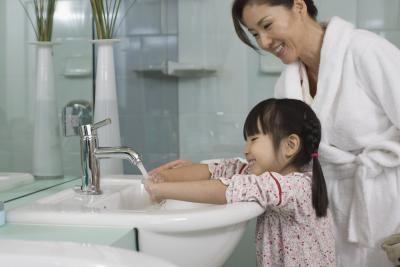Your child isn’t born with an understanding of why he needs to wash dirt and germs, even if they are invisible, from his skin. You need to explain to him how to stay clean and why doing so is important, not just for his appearance, but for the health of others around him. Good habits, such as good hygiene, need to start early in life. Set up a regular cleaning schedule for your child to follow every day.
Step 1
Demonstrate to your children how to wash their hands, face and bodies properly. Squirt some hand soap onto your hands and your child’s hands. Turn the water on and place both your hands under the running water. Rub them together while you sing “Happy Birthday” or another short jingle your child likes. Wash your hands for at least 20 seconds. Use a towel to dry both hands completely.
Step 2
Make bath time fun time. Give your child toys to play with after he successfully washes each body part. For instance, after he washes his face with soap and a washcloth, hand him a rubber ducky. When he washes his arms, legs and tummy, hand him a toy boat. You may need to help him wash those hard-to-reach areas, such as behind his ears, backside and neck.
Step 3
Help her wash her hair. She may be scared of the shampoo, especially if she’s young. Have her close her eyes while your lather her hair, then place her hands on her scalp and help her lather her hair. Tilt her head back and pour pitchers of water on her hair to rinse it out. Explain how shampoo works and why you need to wash it out.
Step 4
Set a routine. Make a list with your child of all the times he should wash his hands: before eating, after using the bathroom, and when he sneezes. Make a list of when he should shampoo his hair or bathe and a list of when he should brush his teeth: after eating and before bedtime.
Step 5
Make a sticker chart with each hygiene task: bathing, washing her hair, brushing her teeth and washing her hands and each day of the week on it. Have her place a sticker on the chart each time she completes a hygiene task. If every spot has a sticker at the end of the week, give her a reward, such as a small toy.
Step 6
Let your child pick out his soap and shampoo. Keep in mind this may mean you’ll end up spending a long time in the soap aisle, as your child sniffs every option. But 20 minutes in the aisle is better than buying a soap your child refuses to use because it smells yucky.
Step 7
Use nail clippers to keep your child’s nails trim and a nail brush to scrub away any dirt. If you want, help your daughter paint her nails, so that she is more inclined to keep them neat and clean.





